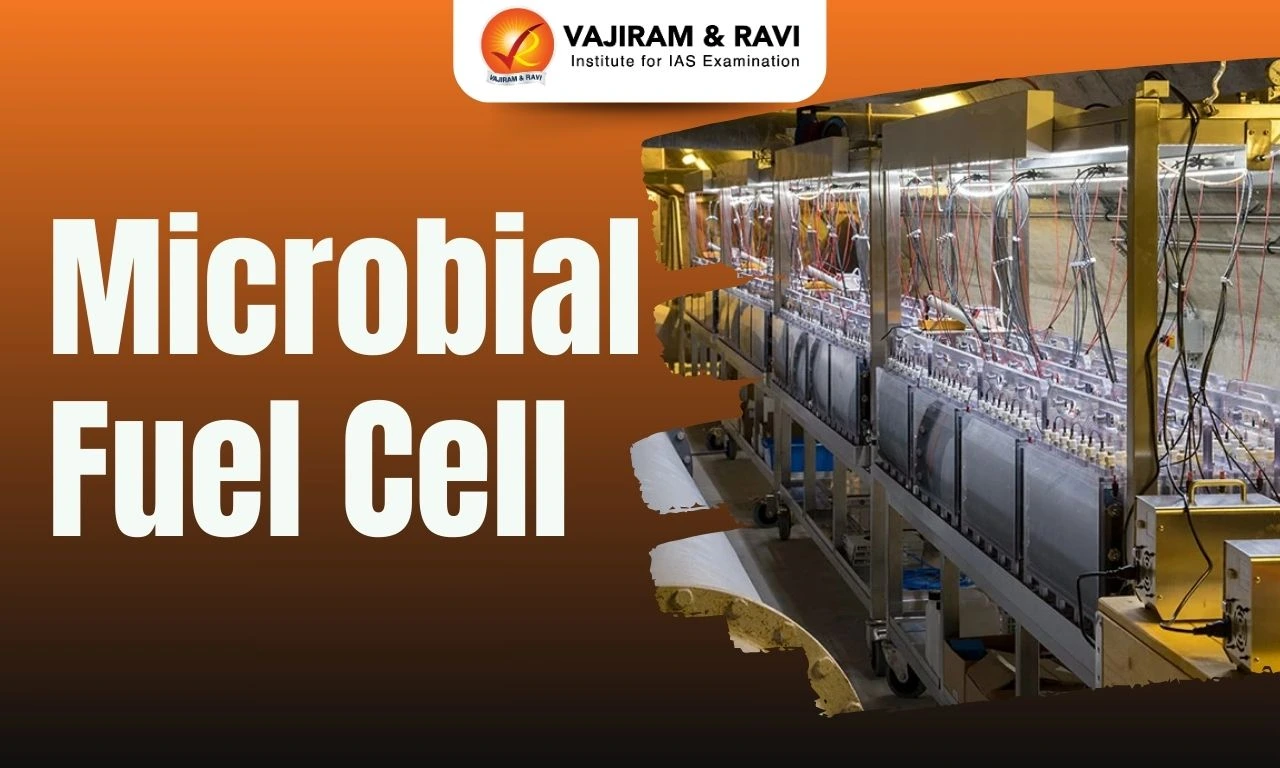Microbial fuel cells (MFCs) are the types of fuel cells that utilise microbial metabolism to produce electrical current using a wide range of organic substrates. They can be considered “the bioreactors that convert the energy in the chemical bonds of organic compounds into electrical energy through the catalytic activity of microorganisms under anaerobic conditions”.
Due to its potential in the production of sustainable energy from organic wastes, research on Microbial Fuel Cells has intensified in the last few years.
Microbial Fuel Cell Structure and Working Principles
The workings of microbial fuel cell (MFC) technology are primarily based on the principle of redox reactions. In the MFCs, organic matter (generally waste materials) and microbes (generally bacteria) are used as substrates (electrolytes), in which electrons are generated through biochemical reactions.
- The natural metabolism of the microbes is used to generate electricity by releasing carbon dioxide (CO2) and water in this process, which is similar to the aerobic respiration of living beings.
- MFCs can use agricultural byproducts and waste materials as a source of substrate.
- MFCs are generally two-chambered, but other variations such as single-chambered MFCs can be used.
The Two-Chambered MFC
The two-chambered Microbial Fuel Cell is shown below, which illustrates the workings of MFC technology.

- Basic structure:
- It is made up of two chambers, containing the anode and cathode separately.
- The anode is kept anaerobic and the cathode aerobic.
- The chambers are separated by a membrane, which is either a cation exchange membrane or a proton exchange membrane, as only protons are permitted to diffuse through it.
- Working principle:
- Anode reaction: At the anode, microorganisms anaerobically oxidise the substrate (fuel), thereby producing CO2 along with protons and electrons. Anodic Reaction: CH3COO- + H2O = 2CO2 + 2H+ + 8e−
- Movement of protons: The exchange membrane transports the protons to the cathode chamber.
- Generation of electricity: In order to create electricity, the electrons are moved from the anode chamber to the cathode chamber using an external electrical circuit.
- Cathode reaction: Protons (through the membrane) and electrons (through the circuit) are used up at the cathode, where they combine with oxygen (O2) to form water.
Cathodic Reaction: O2 + 4H+ 4e− = 2H2O (where E° = 1.23 Volts)
- Role of Oxygen: According to the above reactions, oxygen must be constantly consumed in order to maintain the potential for the production of electricity.
- The oxygen is supplied in the cathode chamber either by bubbling the water or by using an air cathode.
- Oxygen has the highest redox potential. As a result, it is regarded as a superior cathodic electron receiver.
Single-Chambered Microbial Fuel Cell
This microbial fuel cell design contains only one anode chamber, which is coupled with an outer cathode (air-cathode) to transfer protons and electrons.
- The figure below depicts a single-chambered MFC's design.

Advantages of Microbial Fuel Cells
The advantages and disadvantages of microbial fuel cells are described below.
- Alternate source of energy: MFCs use easily available microbes as catalysts and organic waste materials as fuels.
- MFCs, therefore, can be proven to bean alternate and renewable source of energy.
- Biodegradation/bioremediation of wastes: The functioning of MFCs can be used as bioremediation or biodegradation.
- Minimising wastewater discharge: MFCs can address the issue of direct wastewater discharge into the environment.
- No need for infrastructure: Unlike other fuel cells, MFCs do not require dedicated infrastructure in production as well as distribution.
- Better than enzymatic fuel cells: Compared to enzymatic fuel cells, MFCs can harvest up to 90% more electrons from the bacterial electron transport system, demonstrating their high conversion efficiency.
Applications of Microbial Fuel Cells
The applications of Microbial Fuel Cells are limited to specific sectors now, which can be transformed to wide use as research and development proceeds. A few applications of MFCs are:
- Powering underwater monitoring devices: Devices intended to monitor underwater environments like rivers may be powered by Microbial Fuel Cells, where it is difficult to regularly access the system to replace batteries.
- Power supply to remote sensors: Chemical sensors and telemetry systems powered by batteries may be expensive and time-consuming. Using self-renewable power supplies, like MFCs, which can run for a long time using local resources, is one potential solution to this issue.
- Biological Oxygen Demand Sensing: Utilising Microbial Fuel Cell technology as a sensor for in-situ monitoring and controlling pollution is another potential application.
- MFCs may be used as BOD sensors due to their efficiency in assimilating organic contaminants in wastewater.
- Green-Hydrogen Production: Modified MFCs that run on organic waste can be used to produce green-hydrogen.
- The term "bio-electrochemically assisted microbial reactors" (BEAMR) refers to these modified MFCs.
Even though MFC technology holds great promise as a renewable energy source, it will take some time before large-scale and efficient MFCs are available for common usage. Given ongoing global endeavours for alternative energy, research groups across the world will definitely overcome the current limitations of Microbial Fuel Cells, like low power output.
Last updated on November, 2025
→ Check out the latest UPSC Syllabus 2026 here.
→ Join Vajiram & Ravi’s Interview Guidance Programme for expert help to crack your final UPSC stage.
→ UPSC Mains Result 2025 is now out.
→ UPSC Notification 2026 is scheduled to be released on January 14, 2026.
→ UPSC Calendar 2026 is released on 15th May, 2025.
→ The UPSC Vacancy 2025 were released 1129, out of which 979 were for UPSC CSE and remaining 150 are for UPSC IFoS.
→ UPSC Prelims 2026 will be conducted on 24th May, 2026 & UPSC Mains 2026 will be conducted on 21st August 2026.
→ The UPSC Selection Process is of 3 stages-Prelims, Mains and Interview.
→ UPSC Result 2024 is released with latest UPSC Marksheet 2024. Check Now!
→ UPSC Prelims Result 2025 is out now for the CSE held on 25 May 2025.
→ UPSC Toppers List 2024 is released now. Shakti Dubey is UPSC AIR 1 2024 Topper.
→ UPSC Prelims Question Paper 2025 and Unofficial Prelims Answer Key 2025 are available now.
→ UPSC Mains Question Paper 2025 is out for Essay, GS 1, 2, 3 & GS 4.
→ UPSC Mains Indian Language Question Paper 2025 is now out.
→ UPSC Mains Optional Question Paper 2025 is now out.
→ Also check Best IAS Coaching in Delhi
Microbial Fuel Cell FAQs
Q1. What are microbial fuel cells?+
Q2. Which membrane separates the anode and cathode in microbial fuel cells?+
Q3. What are the advantages of microbial fuel cells?+
Q4. What are the disadvantages of microbial fuel cells?+
Q5. What are the applications of microbial fuel cells?+
Tags: microbial fuel cell quest

















